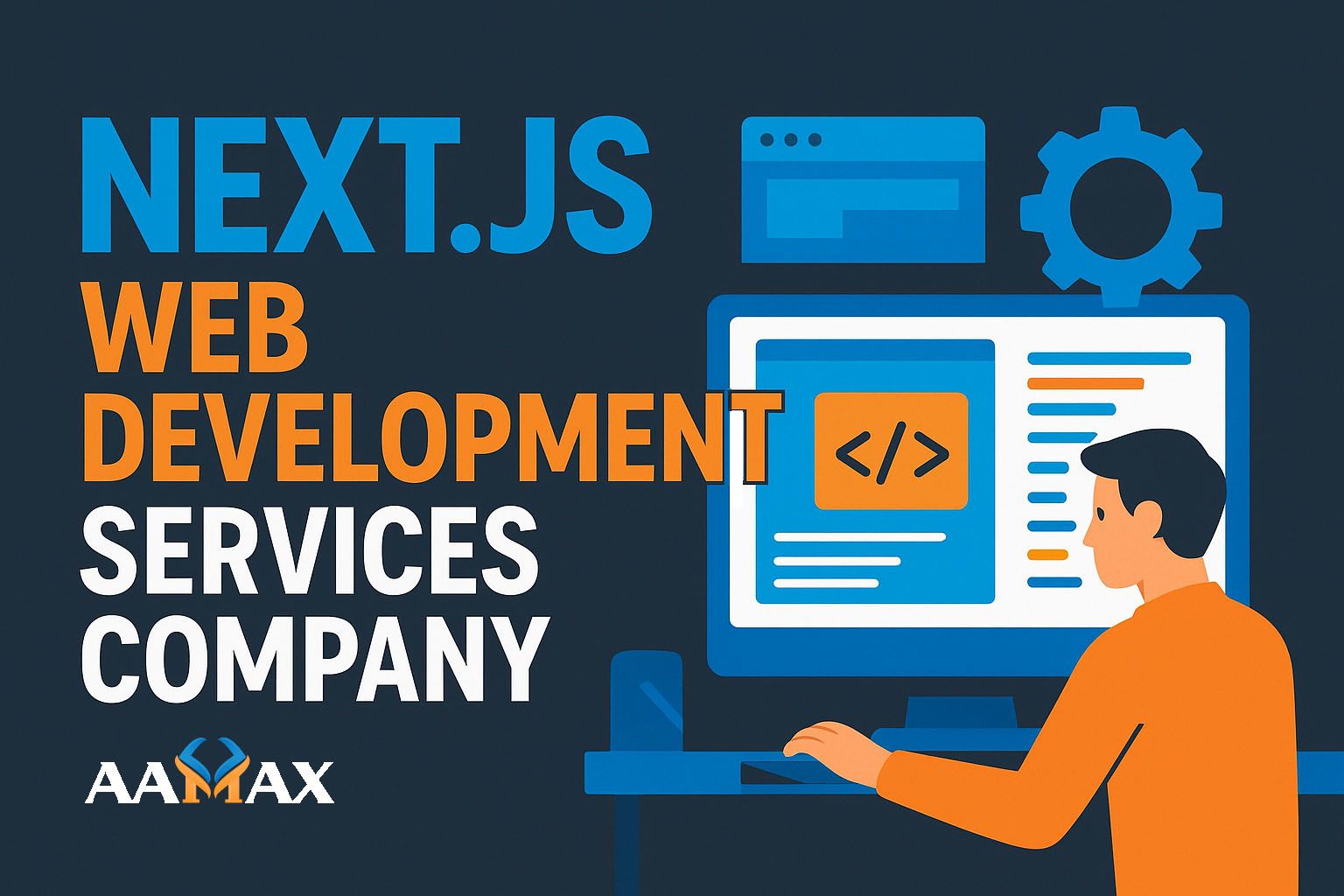
Next.js Web Development Services Company
Why Next.js Matters for Modern Web Development
Next.js has become the go-to framework for building fast, scalable, and SEO-friendly web applications. Built on top of React, Next.js combines the benefits of server-side rendering (SSR), static site generation (SSG), image optimization, and incremental static regeneration (ISR) with developer-friendly features like file-based routing and API routes. For businesses that need performant websites, robust user experiences, and strong search-engine visibility, hiring a specialized Next.js web development company is a smart strategic choice.
If you're ready to accelerate your web projects with experienced professionals, hire AAMAX Next.js Web Development Services Company. AAMAX is a full-service digital marketing company that offers Web Development, Digital Marketing, and SEO Services.
Who Should Consider Next.js Development Services?
Next.js is a versatile choice that fits a wide spectrum of use cases:
- Startups looking to launch fast, iterate quickly, and validate products without sacrificing performance.
- Enterprises needing scalable, maintainable architectures and strong developer experience (DX).
- E-commerce sites requiring fast loading times, dynamic product pages, and SEO-ready content.
- Content-heavy platforms (news, blogs, knowledge bases) that benefit from SSG for speed and SSR for dynamic personalization.
- SaaS products that require server-side logic, authentication flows, and API integrations.
A professional Next.js web development company tailors the framework to your product, business model, and growth plans.
Core Next.js Capabilities Your Development Partner Should Offer
When evaluating a Next.js development company, look for the following capabilities and services:
1. Architecture & Planning
- Project scoping: business goals, KPIs, feature prioritization.
- Tech stack design: Next.js version selection, TypeScript adoption, state management (e.g., Redux, Zustand), and backend choices.
- Scalability planning: modular architecture, micro-frontends where appropriate, and API design.
2. Performance Engineering
- Server-side rendering (SSR): for dynamic, SEO-critical pages.
- Static site generation (SSG) & ISR: for fast, cacheable pages that can update incrementally.
- Image optimization & lazy loading: Next/Image and efficient asset pipelines.
- Code-splitting and tree-shaking: minimize bundle sizes and improve time-to-interactive.
3. SEO & Accessibility
- SEO-first rendering: pre-rendered pages, correct meta tags, structured data (JSON-LD).
- Semantic HTML & ARIA standards: accessibility best practices to reach wider audiences.
- Performance-led SEO: Core Web Vitals improvements to help ranking and user experience.
4. UX/UI Implementation
- Pixel-perfect builds: from Figma/Sketch designs to responsive Next.js components.
- Design systems & component libraries: reusable components, theme tokens, and scalable CSS approaches (Tailwind, CSS Modules, Styled Components).
- Animation and interaction: Framer Motion or CSS-based micro-interactions for polished UX.
5. Integration & Backend Services
- API integrations: REST, GraphQL (Apollo/Relay), or tRPC for type-safe endpoints.
- Headless CMS integrations: Strapi, Contentful, Sanity, or WordPress headless setups.
- E-commerce integrations: Shopify, BigCommerce, custom storefront APIs.
- Authentication & security: NextAuth.js, JWT, OAuth flows, and secure session management.
6. Testing & Quality Assurance
- Unit & integration testing: Jest, React Testing Library.
- End-to-end testing: Playwright or Cypress for full-path verification.
- CI/CD pipelines: automated tests, linting, and deployment to Vercel, Netlify, AWS, or other cloud providers.
7. DevOps & Deployment
- Environment provisioning: staging/production parity, secrets management.
- Edge deployments & caching strategies: leverage Vercel or other CDNs for low-latency global delivery.
- Monitoring & observability: Sentry, LogRocket, Datadog, and performance monitoring tools.
Typical Next.js Project Workflow with a Professional Agency
A well-run Next.js project follows a predictable, transparent workflow:
-
Discovery & Requirements Gathering
Deep-dive workshops to understand goals, audience, and constraints. -
Prototyping & Design
UX flows, wireframes, and high-fidelity mockups. Design tokens and component specs. -
Architecture & Sprint Planning
Break down features into sprints, define milestones, and create a delivery roadmap. -
Development & Continuous Integration
Component development, API integrations, and daily builds. Pull-request reviews and automated testing. -
Performance & SEO Audit
Lighthouse checks, Core Web Vitals tuning, and metadata/structured data implementation. -
User Acceptance Testing (UAT) & Accessibility Testing
Stakeholder sign-off, A11y checks, and bug fixes. -
Launch & Post-Launch Support
Rollout plan, monitoring, and iterative improvements based on analytics. -
Ongoing Optimization & Growth
Conversion rate optimization (CRO), A/B testing, and SEO content strategies.
Case Studies: Where Next.js Delivers Tangible Value
E-commerce Storefront
A retailer migrating from a monolithic CMS to a headless Next.js storefront can reduce page load times, improve mobile conversions, and gain flexibility to run personalized promotions. Combining SSR for product pages and SSG for static content yields both performance and fresh inventory data.
Content Platform
A publisher using Next.js with SSG for articles and ISR for breaking news can ensure near-instant page loads and reliable SEO. Integration with a headless CMS (e.g., Sanity) provides content teams with quick publishing workflows.
SaaS Marketing & App Hybrid
A SaaS company can use Next.js to serve a marketing site (SSG) and the application shell (SSR + client-side hydration) from the same codebase, sharing components and speed up development cycles.
How to Choose the Right Next.js Development Company
When selecting an agency or partner, evaluate:
- Portfolio & References: Look for projects similar in scope and complexity.
- Technical proficiency: TypeScript, modern React patterns, knowledge of Next.js internals.
- SEO & Marketing alignment: Can they deliver technical SEO and content strategies?
- Design-to-code workflows: Do they convert designs faithfully and responsively?
- Communication & process: Clear SLAs, reporting cadence, and a collaborative approach.
- Post-launch support: maintenance, monitoring, and iterative optimization services.
A partner who understands both development and digital marketing (SEO, CRO, performance content) offers higher long-term ROI because it aligns technical outputs with business outcomes.
Cost Considerations & Pricing Models
Next.js development costs vary with project complexity, team structure, and timelines. Typical pricing models include:
- Fixed-price projects: Best for well-defined scopes; requires detailed specifications.
- Time & materials (hourly): Flexible for projects that will evolve; pay for actual hours worked.
- Dedicated team/monthly retainer: Ideal for long-term product development, continuous feature delivery, and optimization.
Cost drivers to consider:
- Integrations (payments, third-party APIs)
- Custom visuals and animations
- Authentication and security needs
- Multi-language/localization support
- Enterprise-grade SLAs and compliance requirements
A transparent development company will provide a clear breakdown—discovery, design, development, QA, deployment, and post-launch support—so you can make informed choices.
Best Practices for Successful Next.js Projects
To maximize success and longevity of your Next.js application, adopt these best practices:
- Use TypeScript: Strong typing reduces bugs and improves developer productivity.
- Leverage modular components: Reusable components speed development and lower maintenance.
- Optimize images & media: Use Next’s image handling and serve responsive formats (WebP/AVIF).
- Implement caching & CDN rules: Use edge caching for static assets and appropriate cache-control for dynamic content.
- Automate testing and linting: CI pipelines with unit, integration, and E2E tests prevent regressions.
- Monitor real-user metrics: Track Core Web Vitals and real-user performance (RUM) to uncover real-world bottlenecks.
- Document design systems & APIs: Documentation helps new team members onboard quickly and ensures consistent UX.
Common Pitfalls & How an Expert Agency Avoids Them
Pitfall: Overusing SSR
SSR provides fresh content but can add server load. Expert teams balance SSR, SSG, and client-side rendering for optimal performance and cost.
Pitfall: Ignoring SEO Metadata
Forgetting structured data and canonical tags undermines search visibility. Professionals implement thorough SEO audits and metadata strategies.
Pitfall: Tight Coupling Between Frontend and Backend
Hard-coded APIs and monolithic patterns make maintenance painful. Experienced teams advocate for decoupled APIs and versioned contracts.
Pitfall: Skipping Accessibility
Accessibility issues alienate users and risk compliance violations. Reputable agencies include accessibility checks in every sprint.
What to Expect After Launch: Maintenance & Growth
A live site is just the beginning. Ongoing activities to keep your Next.js product healthy include:
- Performance tuning: continuous tracking and optimization of Core Web Vitals.
- Security patches: dependency updates, vulnerability scanning, and remediation.
- Feature roadmap execution: prioritized enhancements based on analytics and user feedback.
- SEO & content strategy: regular content updates, schema enhancements, and technical SEO maintenance.
- A/B testing & personalization: iterate on funnels to increase conversions and user engagement.
An agency that blends development with digital marketing expertise helps you convert traffic into measurable business outcomes.
Why Partner with a Full-Service Digital Agency?
Working with a full-service digital marketing agency that understands both development and marketing creates synergy:
- Development teams build technically sound, high-performance experiences.
- Marketing teams ensure those experiences reach the right audience with optimized messaging and SEO.
- Unified reporting and KPIs help you make data-driven decisions that connect technical work to business metrics.
If you want a partner that can both build and grow your Next.js product, consider a team with cross-disciplinary strengths.
Getting Started: First Steps to Launch a Next.js Project
- Define business goals and KPIs (traffic, conversions, time-to-interact).
- Assemble stakeholders for a discovery session (product, design, dev, marketing).
- Audit existing assets (current site, analytics, content).
- Create a prioritized roadmap with MVP features and milestones.
- Select a partner with proven Next.js experience and marketing alignment.
Remember that the right partner not only delivers code but helps you achieve measurable growth.
Final Thoughts
Next.js is a powerful tool for companies that demand speed, SEO, and developer productivity. Choosing the right Next.js web development company means selecting a partner that balances engineering excellence with marketing and growth thinking. Whether you’re launching a new storefront, migrating a legacy CMS, or building a complex SaaS product, a skilled Next.js team will ensure your product performs well today and scales tomorrow.
If you’re ready to get started, hire AAMAX for Next.js Web Development Services Company. Their combined expertise in web development, digital marketing, and SEO ensures your Next.js project is built for performance, discoverability, and conversion.







